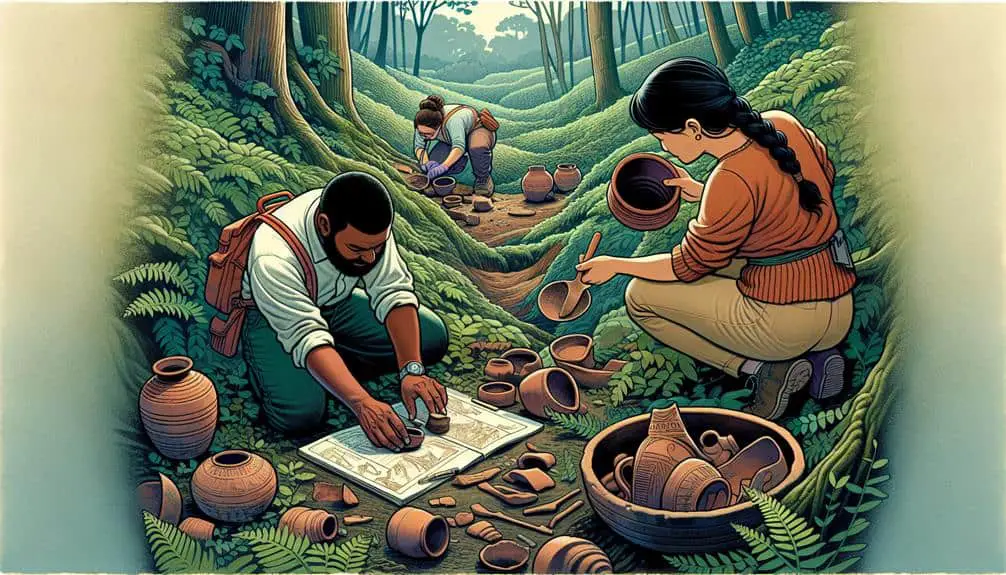When preserving Native American settlement remnants, it is crucial to research local history, engage with indigenous communities, document artifacts and structures, obtain necessary permits, implement conservation measures, educate the public, and partner with preservation organizations. Research local history to understand the context. Engage with indigenous communities with cultural sensitivity. Document artifacts meticulously for historical insights. Obtain permits promptly and comply with regulations. Implement conservation measures to protect the site. Educate the public about cultural significance. Partner with preservation organizations for support. These tips are essential for respectfully preserving Native American heritage sites. Preserve with care.
Key Points
- Collaborate with local tribes for authentic preservation efforts.
- Document artifacts and structures meticulously for historical record.
- Implement conservation measures to protect fragile remnants.
- Engage in educational outreach programs for public awareness.
- Strategically place clear, multilingual signage for site interpretation.
Research Local History
Have you explored the local archives and historical records to uncover the intricate history of Native American settlements in your area? To investigate the rich past of these settlements, it's essential to examine archaeological findings and collaborate with historians. By exploring archaeological sites in the vicinity, you can unearth valuable artifacts and structures that provide insights into how Native American communities lived and interacted with the environment.
Collaborating with historians allows you to piece together the historical narrative of these settlements, filling gaps in your understanding and gaining a thorough view of their significance. By cross-referencing historical records with archaeological discoveries, you can create a more detailed and precise portrayal of the Native American presence in your region.
Through these investigative efforts, you can gain a deeper appreciation for the cultural heritage of Native American communities and contribute to the preservation of their legacy. By exploring archaeological findings and working closely with historians, you can honor the past and make sure that the stories of these settlements endure for future generations.
Engage With Indigenous Communities
To deepen your understanding of Native American settlements and contribute to their preservation, engaging with Indigenous communities is an essential step towards fostering mutual respect and collaboration. Community engagement with Indigenous groups allows for a more thorough approach to preserving Native American settlement remnants while respecting their cultural significance.
Here are some tips for engaging with Indigenous communities:
- Approach with Cultural Sensitivity: Respect the traditions, beliefs, and practices of the Indigenous community you're engaging with.
- Listen Actively: Take the time to listen to the perspectives and concerns of the community members regarding the preservation of their heritage.
- Build Trust: Establishing trust is pivotal for successful collaboration. Be honest, transparent, and respectful in your interactions.
- Seek Guidance: Consult with Indigenous leaders or cultural advisors to make sure your efforts align with the community's values and goals.
Document Artifacts and Structures
When documenting artifacts and structures related to Native American settlements, meticulous attention to detail is essential for accurately preserving and cataloging historical elements. Artifact preservation involves carefully recording each item's location, dimensions, material composition, and any unique markings or symbols. Use proper labeling techniques to guarantee easy identification and tracking of artifacts during preservation. Additionally, consider creating detailed sketches or photographs of structures to capture their current state and any distinguishing features.
Structure documentation plays an important role in understanding the layout and purpose of different buildings within a settlement. Take measurements of structures, note any architectural patterns, and document the materials used in construction. This information can provide valuable insights into the daily lives and activities of the Native American communities that once inhabited these spaces. By meticulously documenting artifacts and structures, you contribute to the preservation of history and make sure that future generations can learn from and appreciate these important remnants of the past.
Obtain Necessary Permits
When preserving Native American settlement remnants, obtaining necessary permits is vital to guarantee compliance with regulations. These permits are essential for the preservation of artifacts and structures that hold historical significance.
Make sure to thoroughly research and acquire the required permits before starting any preservation work to avoid legal issues.
Permits for Preservation
Before commencing any preservation efforts, make certain that all required permits have been obtained. This guarantees that you can proceed with your project without any legal hurdles.
Here are some essential steps to contemplate:
- Research: Start by researching the specific permits needed for conserving Native American settlement remnants.
- Contact Authorities: Reach out to local authorities or relevant agencies to understand the permitting process.
- Submit Applications: Complete and submit all necessary permit applications promptly to avoid delays.
- Follow Up: Stay proactive by following up on the status of your permit applications to address any potential issues promptly.
Compliance With Regulations
To guarantee the successful preservation of Native American settlement remnants, the first step is to secure all necessary permits in compliance with regulations.
Cultural sensitivity and ethical considerations are paramount when dealing with sites of historical significance. Before undertaking any preservation efforts, it's essential to understand and respect the cultural heritage attached to these locations.
Additionally, being mindful of the environmental impact is vital to make certain the long-term sustainability of the site. Proper land management practices should be implemented to safeguard the natural surroundings while preserving the historical integrity of the settlement remnants.
Implement Conservation Measures
To successfully implement conservation measures for Native American settlement remnants, it's vital to monitor soil erosion regularly to prevent degradation of the site. Protecting fragile structures through appropriate barriers or restricted access can help maintain the integrity of the remnants.
Additionally, using proper signage to educate visitors about the historical significance of the site and the importance of preservation is essential for long-term conservation efforts.
Monitor Soil Erosion
Implementing conservation measures to monitor soil erosion is essential for preserving Native American settlement remnants. To effectively control erosion and protect these historical sites, you should consider the following:
- Regular Inspections: Conduct routine checks to identify any signs of erosion.
- Implement Vegetation: Plant native vegetation to stabilize soil and prevent erosion.
- Use Mulch or Coverings: Apply mulch or other coverings to protect exposed soil from erosion.
- Divert Water Flow: Create barriers or diversion channels to manage water runoff and prevent erosion from impacting the settlement remnants.
Protect Fragile Structures
When considering the protection of fragile structures within Native American settlement remnants, it's important to implement conservation measures that prioritize structural integrity and historical preservation.
Research techniques such as non-invasive surveys, 3D modeling, and material analysis can aid in understanding the unique construction methods and materials used in these structures. By identifying the most vulnerable areas through detailed research, targeted conservation efforts can be applied to guarantee the longevity of these fragile remnants.
Monitoring environmental conditions like humidity, temperature, and exposure to sunlight is essential for preserving the structural stability of these delicate buildings. Implementing protective measures such as barriers to prevent physical damage, controlled access to limit human impact, and regular maintenance checks are critical steps in safeguarding these valuable remnants for future generations.
Use Proper Signage
Preserving Native American settlement remnants involves utilizing proper signage as an integral part of implementing conservation measures. Signage placement plays a vital role in educating visitors and guaranteeing the protection of these historical sites.
To effectively use signage in preserving Native American settlement remnants, consider the following:
- Strategic Placement: Position signs at key locations to guide visitors and prevent unintentional damage.
- Clear Information: Provide concise and accurate details about the significance of the site and guidelines for respectful behavior.
- Multilingual Signage: Consider incorporating multiple languages to cater to a diverse audience.
- Community Involvement: Engage local tribes and communities in designing and reviewing signage to ensure cultural sensitivity and accuracy.
Educate the Public
To effectively educate the public about preserving Native American settlement remnants, creating engaging and informative outreach programs is essential. These programs should focus on raising awareness about the historical significance of these sites and fostering understanding of the importance of preserving them for future generations. By engaging the public through educational initiatives such as guided tours, workshops, and informational signage, you can help instill a sense of respect and appreciation for Native American history and culture.
Utilizing various platforms like social media, community events, and school programs can reach a wider audience and make information more accessible. Incorporating interactive elements into these educational programs, such as hands-on activities or multimedia presentations, can further enhance the learning experience and generate more interest in preservation efforts.
Partner With Preservation Organizations
Partnering with preservation organizations can greatly enhance your efforts in safeguarding Native American settlement remnants by leveraging expertise and resources. Collaborative efforts with these organizations can provide valuable support in ensuring the preservation and protection of these culturally significant sites.
Here are some key benefits of partnering with preservation organizations:
- Access to Specialized Knowledge: Preservation organizations often have experts well-versed in heritage conservation and archaeological practices.
- Increased Funding Opportunities: By collaborating, you may gain access to funding sources or grants specifically aimed at preserving Native American settlement remnants.
- Community Engagement: Partnering with preservation organizations can help foster community involvement and support for preservation initiatives.
- Enhanced Cultural Sensitivity: These organizations can provide guidance on how to approach preservation efforts with the necessary cultural sensitivity required when dealing with Native American heritage.
Frequently Asked Questions
How Can I Involve Children and Youth in the Preservation Efforts of Native American Settlement Remnants?
To involve children and youth in preserving Native American settlement remnants, engage them in hands-on activities like artifact hunts and storytelling. Encourage community involvement through workshops and field trips to foster appreciation for cultural heritage.
Are There Any Specific Guidelines or Best Practices for Handling and Preserving Delicate Artifacts Found at These Sites?
When handling delicate artifacts from Native American sites, remember to use gentle techniques for preservation. Engaging indigenous communities in education about proper conservation methods is essential. Respect their heritage and contribute to preserving history.
What Steps Can Be Taken to Ensure That the Conservation Measures Implemented Are Sustainable in the Long Term?
To guarantee long term sustainability of conservation measures, involve the community in decision-making. Engage with stakeholders, create educational programs, and establish monitoring systems. By fostering collaboration and awareness, preservation efforts can be more effective and enduring.
Are There Any Specific Challenges or Considerations When Working With Multiple Indigenous Communities on a Preservation Project?
When working with multiple indigenous communities on a preservation project, community engagement is key. Cultivate trust through active listening and respect for cultural sensitivity. Challenges may arise due to differing traditions and priorities, requiring flexibility and collaboration.
How Can Technology, Such as Drones or 3D Scanning, Be Utilized to Assist in Documenting and Preserving These Settlement Remnants?
Utilize drone mapping for aerial surveys, employ 3D scanning in documentation for detailed preservation records. Develop virtual reality experiences for immersive learning. Implement educational outreach programs to engage communities in the significance of Native American settlement remnants.



